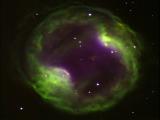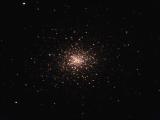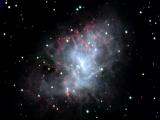 |
Planetary Nebula PK164+31.1 Planetary Nebula in the constellation Lynx. PK164+31.1, also known as Jones-Emberson 1, is a low bright planetary nebula that lies about 1,600 light years away towards the constellation Lynx. Due to its magnitude 17 it is only visible in good-size telescopes. A hot blue white dwarf star near the center of the nebula is what remains of the nucleus because the gas is expelled at different times (as can be seen the image) at the end of the life of the star. The expanding nebula will fade over the next thousands of years while the central star can survive for billions of years. Image: Combination of 3 images of 900 seconds in the Hα, NII and OIII filters taken with the CCDT150 camera of the T150 telescope. 10/01/2017 L.F. Miranda |
 |
M2 Globular Cluster in the constellation of Aquarius. This cluster is about 37500 light-years distnat from Earth and it is at 175 light-years in diameter, so it is one of the larger globular clusters known. It is 13 billion years old and one of the older globulars associated with Milky Way. The cluster is compact and rich in stars, about 150000, inluding 21 known variable stars. Photograph: combination o a serie of 3x120 second images on each of the Johnson BVR filters taken with the T150 telescope. 10/10/2006 |
 |
M1 (Crab Nebula) Nebula in the constellation of Taurus. The Crab Nebula is a supernova remnant of plerion type (is a nebula powered by the pulsar wind of a pulsar). At the center of the nebula lies a pulsar with a spin rate of 30.2 times per second which emits pulses of radiation from gamma rays to radio waves. The nebula lies in the Perseus Arm of the Milky Way galaxy. It is located at a distance of about 1930 parsec (6300 light years) from Earth, it has a diameter of 3.4 parsec (11 light years) and it is expanding at a rate of about 1,500 km/s. The discovery of the nebula was the first evidence to show that supernova explosions produce pulsars. Photograph: combination of 6 200-second images on each of the Johnson BVI filters taken with the CCDT150 camera attached to T150 telescope. |